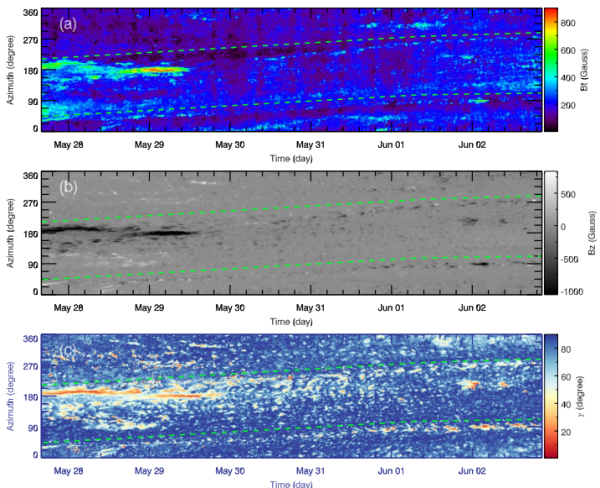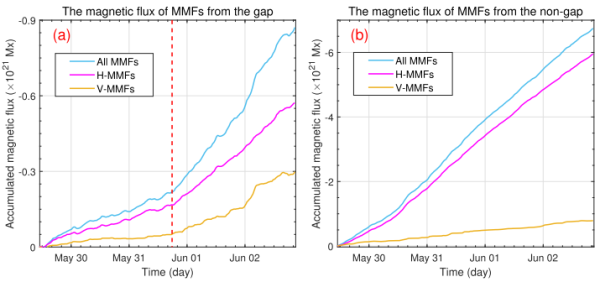Using the high spatial and temporal resolution observational data from the Solar Dynamic Observatory (SDO), Dr. PENG Yang, Professor QU Zhongquan, Professor XUE Zhike and their collaborators from the FASOT and the Fuxian Lake Solar Observatory have studied the fine physical magnetic field properties of moving magnetic features generated from different regions of a decaying sunspot. The relevant research results were published in the international astronomical journal The Astrophysical Journal.
Moving magnetic features are thought to be a manifestations of the diffusion of the sunspot magnetic field. The moving features are divided into three types, the type I features are bipolar magnetic features, and the type II and III are unipolar, which are the same and opposite polarity as the parent sunspots, respectively. The formation of type I and III moving magnetic features is thought to result from the intersection of the horizontal penumbral magnetic field with the photosphere. These two moving magnetic features have little to do with the disintegration of the magnetic field of the sunspot, whereas the type II moving magnetic features are closely related to sunspot magnetic field diffusion.
Current physical models for the formation of moving magnetic features rely mainly on penumbral magnetic fields. However, many recent studies have shown the presence of a large number of moving magnetic features around pores. Nevertheless, the formation mechanism and physical properties of moving magnetic features are still not well understood.
Through a detailed study of the decay process of two adjacent α-configuration sunspots in the active region 13023 on May 27, 2022, the researchers found that the moving magnetic features generated from the non-penumbra region usually exhibit strong longitudinal magnetic field strength and a small magnetic field inclination (γ), whereas, the magnetic field of the moving magnetic features generated around the penumbra region is usually horizontal and the longitudinal magnetic field is weaker. The ratio of the magnetic flux of vertical moving magnetic features (0°<γ<45°) to the total magnetic flux in the non-penumbra region is much larger than that around the penumbra region. Therefore, the researchers concluded that, during the decay of the two sunspots, the moving magnetic features produced in the non-penumbra region originates directly from the sunspot umbra.
The study was sponsored by the National Science Foundation of China (NSFC), and the Yunnan Key Laboratory of Solar Physics and Space Science, among others.

Figure 1, the decay process of the two sunspots, the green arrow marks the gap between the two sunspots, and the red arrow marks the representation of the moving magnetic structure generated from the non-penumbra region on the continuum. Image by PENG.

Figure 2, the vector magnetic field properties of the moving magnetic features generated from the penumbra and non-penumbra regions recorded in elliptical slices tightly wrapped in sunspots. Figures (a)-(c) are time-distance diagrams of transverse magnetic field strength, longitudinal magnetic field strength, and magnetic field inclination, respectively, and the green dotted line marks the traces of the moving magnetic features moving outward from the upper and lower openings of the gap. Image by PENG.

Figure 3,the generation of magnetic flux by different moving magnetic features around the non-penumbra regions (b) and penumbra (a), respectively. H-MMFs and V-MMFs represent transverse moving magnetic features and longitudinal moving magnetic features, respectively. Image by PENG.
Contact:
XUE Zhike
Yunnan Observatories, CAS
Email: zkxue@ynao.ac.cn